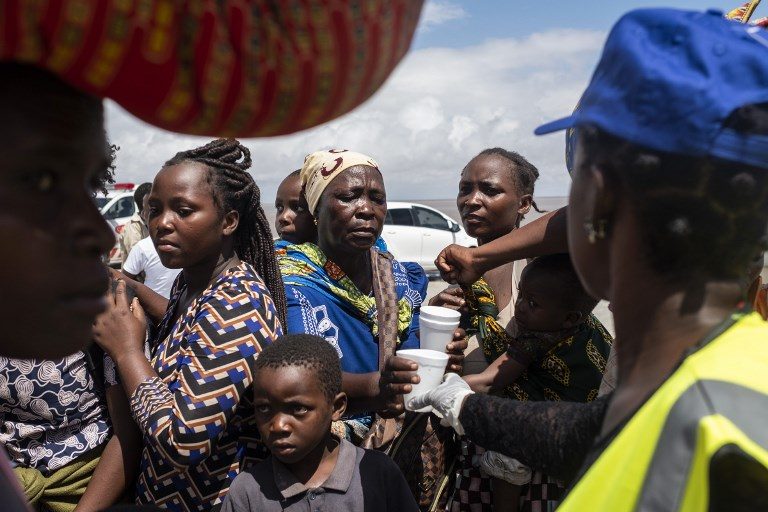SUMMARY
This is AI generated summarization, which may have errors. For context, always refer to the full article.

BEIRA, Mozambique – Aid workers faced disarray, a clamor for help and mounting anger Friday, March 22, as they headed out across central Mozambique, battling to help tens of thousands of people battered by one of southern Africa’s most powerful storms.
A week after Tropical Cyclone Idai lashed Mozambique with winds of nearly 200 kilometers (120 miles) per hour, rescue efforts rose a gear but the situation was often chaotic.
Humanitarian agencies are racing to rescue those still trapped, feed those who have been brought to safety and protect them from malaria and cholera.
“We are running out of time, it is at a critical point here,” UNICEF chief Henrietta Fore told Agence France-Presse (AFP) after she flew into the devastated port city of Beira from New York.
Hygiene and safe drinking water are absolute priorities, she warned.
“There’s stagnant water, it’s not draining, decomposing bodies, lack of good hygiene and sanitation,” Fore said. “We are worried about cholera, about malaria, because of the stagnant water.”
World Food Programme (WFP) spokesman Gerald Bourke said the aid effort was “slow to start, (but)…is now accelerating, thankfully.”
“We are not yet where it needs to be,” Bourke told AFP.
“We are broadening the effort. It’s going to take a lot more because this is going to run for quite a while.”
Relief agencies said the gravity of the cyclone and scale of the flooding it unleashed had been stunning.
The confirmed death toll in Mozambique and neighboring Zimbabwe reached 432 on Friday, with 293 killed in Mozambique, and around 1.7 million people affected.
Districts west of the Mozambican port city of Beira resemble an inland lake, and thousands of people are still trapped on rooftops and on tree branches.
Anger
More than 65,000 people are already in shelters across in central Mozambique and other sites are being opened.
In Dondo, near Beira, food distribution finally started on Thursday, March 21, at one of 20 schools transformed into emergency shelters.
“Today is the first day we receive help,” said survivor Marta Antonio.
“But they don’t give it to everyone, they only give it to those who are in the rooms. But those outside receive nothing,” she said.
Victims who were not housed in the centers were frustrated.
They complained that they had been forgotten and for those lining up for something to eat, the food was insufficient.
“I have 4 children, and they’re only going to eat bread? Give me a bag of aid,” demanded one man, who did not give his name.
In Beira’s Samora Machel Secondary School, where President Filipe Nyusi was educated, more than a thousand people had found shelter. Around 200 of them on Friday slept on the floor of an indoor basketball court.
“Everything is difficult here. I’m fighting for my children to have something to eat,” Celeste Dambo, who said that by by lunchtime had not yet eaten anything since the previous night.
On Wednesday, March 20, crowds of people looted a warehouse, taking away sacks of rice marked “China Aid.”
“People have suffered for weeks here, and they are understandably worried. This is a very difficult situation, on a massive scale, the response is building, you’re going to have hiccups, (but) a lot more people are weighing in,” said Bourke.
The United Nations has launched an appeal for assistance but said it did not yet have enough information to give an accurate estimate of the need.
The United States said Thursday it had sent a team to cyclone-hit Mozambique to provide safe drinking water and other necessities.
The global response could be scaled up once the scope of the disaster becomes clear.
Helicopters and drones
Neighboring South Africa has had teams in Mozambique for nearly a week, having sent in rescue teams 24 hours after the cyclone struck, helping airlifting people from trees and rooftops.
“There’s hundreds of people that we’ve removed to safety, but now there is a second phase of the operation,” to provide humanitarian aid to the displaced,” inspector general Padi Khoase of the South African army told AFP.
There are still some 15,000 stranded people “in bad shape” and still needing to be saved, many of them on rooftops or even in trees, Mozambican Land and Environmental Minister Celso Correia said on Thursday.
On Friday authorities were to deploy new techniques in order to calibrate their response.
“We are using drones, and we will get a better idea of the affected zones,” said Correia. – Rappler.com
Add a comment
How does this make you feel?
There are no comments yet. Add your comment to start the conversation.